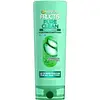What's inside
What's inside
 Key Ingredients
Key Ingredients

No key ingredients
 Benefits
Benefits

 Concerns
Concerns

 Ingredients Side-by-side
Ingredients Side-by-side

Water
Skin ConditioningDistearyldimonium Chloride
Stearyl Alcohol
EmollientStearamidopropyl Dimethylamine Lactate
Cetyl Alcohol
EmollientCocos Nucifera Oil
MaskingGlycerin
HumectantPhenoxyethanol
PreservativeParfum
MaskingGlycine Soja Oil
EmollientPolysorbate 60
EmulsifyingSteareth-20
CleansingMethylparaben
PreservativeSodium Chloride
MaskingPEG-150 Stearate
Hydrolyzed Collagen
EmollientPropylparaben
PreservativeLanolin
EmollientOlea Europaea Fruit Oil
MaskingCI 19140
Cosmetic ColorantBenzyl Benzoate
AntimicrobialAlpha-Isomethyl Ionone
PerfumingHexyl Cinnamal
PerfumingLinalool
PerfumingLimonene
PerfumingCitronellol
PerfumingGeraniol
PerfumingBenzyl Salicylate
PerfumingWater, Distearyldimonium Chloride, Stearyl Alcohol, Stearamidopropyl Dimethylamine Lactate, Cetyl Alcohol, Cocos Nucifera Oil, Glycerin, Phenoxyethanol, Parfum, Glycine Soja Oil, Polysorbate 60, Steareth-20, Methylparaben, Sodium Chloride, PEG-150 Stearate, Hydrolyzed Collagen, Propylparaben, Lanolin, Olea Europaea Fruit Oil, CI 19140, Benzyl Benzoate, Alpha-Isomethyl Ionone, Hexyl Cinnamal, Linalool, Limonene, Citronellol, Geraniol, Benzyl Salicylate
Water
Skin ConditioningCetearyl Alcohol
EmollientElaeis Guineensis Oil
EmollientBehentrimonium Chloride
PreservativePhenoxyethanol
PreservativeGlycerin
HumectantParfum
MaskingIsopropyl Alcohol
SolventPyrus Malus Fruit Extract
Skin ConditioningStearamidopropyl Dimethylamine
EmulsifyingBHT
AntioxidantAloe Barbadensis Leaf Juice
Skin ConditioningLinalool
PerfumingNiacinamide
SmoothingPyridoxine Hcl
Skin ConditioningHexyl Cinnamal
PerfumingCitric Acid
BufferingChlorhexidine Dihydrochloride
AntimicrobialSaccharum Officinarum Extract
MoisturisingTocopherol
AntioxidantHydroxypropyltrimonium Lemon Protein
HumectantCitrus Limon Peel Extract
EmollientLeuconostoc/Radish Root Ferment Filtrate
AntimicrobialCamellia Sinensis Leaf Extract
AntimicrobialPotassium Sorbate
PreservativeSodium Benzoate
MaskingWater, Cetearyl Alcohol, Elaeis Guineensis Oil, Behentrimonium Chloride, Phenoxyethanol, Glycerin, Parfum, Isopropyl Alcohol, Pyrus Malus Fruit Extract, Stearamidopropyl Dimethylamine, BHT, Aloe Barbadensis Leaf Juice, Linalool, Niacinamide, Pyridoxine Hcl, Hexyl Cinnamal, Citric Acid, Chlorhexidine Dihydrochloride, Saccharum Officinarum Extract, Tocopherol, Hydroxypropyltrimonium Lemon Protein, Citrus Limon Peel Extract, Leuconostoc/Radish Root Ferment Filtrate, Camellia Sinensis Leaf Extract, Potassium Sorbate, Sodium Benzoate
 Reviews
Reviews

Ingredients Explained
These ingredients are found in both products.
Ingredients higher up in an ingredient list are typically present in a larger amount.
Glycerin is already naturally found in your skin. It helps moisturize and protect your skin.
A study from 2016 found glycerin to be more effective as a humectant than AHAs and hyaluronic acid.
As a humectant, it helps the skin stay hydrated by pulling moisture to your skin. The low molecular weight of glycerin allows it to pull moisture into the deeper layers of your skin.
Hydrated skin improves your skin barrier; Your skin barrier helps protect against irritants and bacteria.
Glycerin has also been found to have antimicrobial and antiviral properties. Due to these properties, glycerin is often used in wound and burn treatments.
In cosmetics, glycerin is usually derived from plants such as soybean or palm. However, it can also be sourced from animals, such as tallow or animal fat.
This ingredient is organic, colorless, odorless, and non-toxic.
Glycerin is the name for this ingredient in American English. British English uses Glycerol/Glycerine.
Learn more about GlycerinHexyl Cinnamal is a fragrance ingredient with a similar scent to jasmine. It can be naturally found in chamomile essential oil.
This ingredient is a known EU allergen and may sensitize the skin. The EU requires this ingredient to be listed separately on an ingredients list.
Hexyl Cinnamal is not water soluble but is soluble in oils.
Learn more about Hexyl CinnamalLinalool is a fragrance and helps add scent to products. It's derived from common plants such as cinnamon, mint, citrus, and lavender.
Like Limonene, this ingredient oxidizes when exposed to air. Oxidized linalool can cause allergies and skin sensitivity.
This ingredient has a scent that is floral, spicy tropical, and citrus-like.
Learn more about LinaloolParfum is a catch-all term for an ingredient or more that is used to give a scent to products.
Also called "fragrance", this ingredient can be a blend of hundreds of chemicals or plant oils. This means every product with "fragrance" or "parfum" in the ingredients list is a different mixture.
For instance, Habanolide is a proprietary trade name for a specific aroma chemical. When used as a fragrance ingredient in cosmetics, most aroma chemicals fall under the broad labeling category of “FRAGRANCE” or “PARFUM” according to EU and US regulations.
The term 'parfum' or 'fragrance' is not regulated in many countries. In many cases, it is up to the brand to define this term.
For instance, many brands choose to label themselves as "fragrance-free" because they are not using synthetic fragrances. However, their products may still contain ingredients such as essential oils that are considered a fragrance by INCI standards.
One example is Calendula flower extract. Calendula is an essential oil that still imparts a scent or 'fragrance'.
Depending on the blend, the ingredients in the mixture can cause allergies and sensitivities on the skin. Some ingredients that are known EU allergens include linalool and citronellol.
Parfum can also be used to mask or cover an unpleasant scent.
The bottom line is: not all fragrances/parfum/ingredients are created equally. If you are worried about fragrances, we recommend taking a closer look at an ingredient. And of course, we always recommend speaking with a professional.
Learn more about ParfumPhenoxyethanol is a preservative that has germicide, antimicrobial, and aromatic properties. Studies show that phenoxyethanol can prevent microbial growth. By itself, it has a scent that is similar to that of a rose.
It's often used in formulations along with Caprylyl Glycol to preserve the shelf life of products.
Water. It's the most common cosmetic ingredient of all. You'll usually see it at the top of ingredient lists, meaning that it makes up the largest part of the product.
So why is it so popular? Water most often acts as a solvent - this means that it helps dissolve other ingredients into the formulation.
You'll also recognize water as that liquid we all need to stay alive. If you see this, drink a glass of water. Stay hydrated!
Learn more about Water